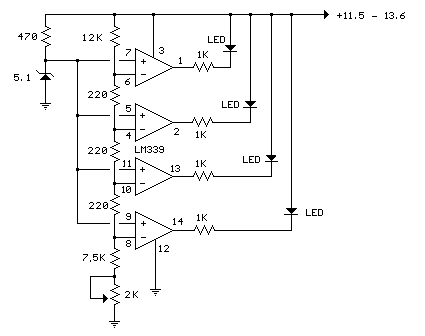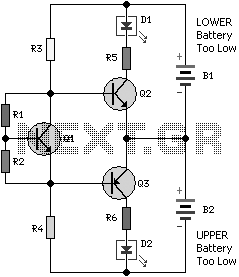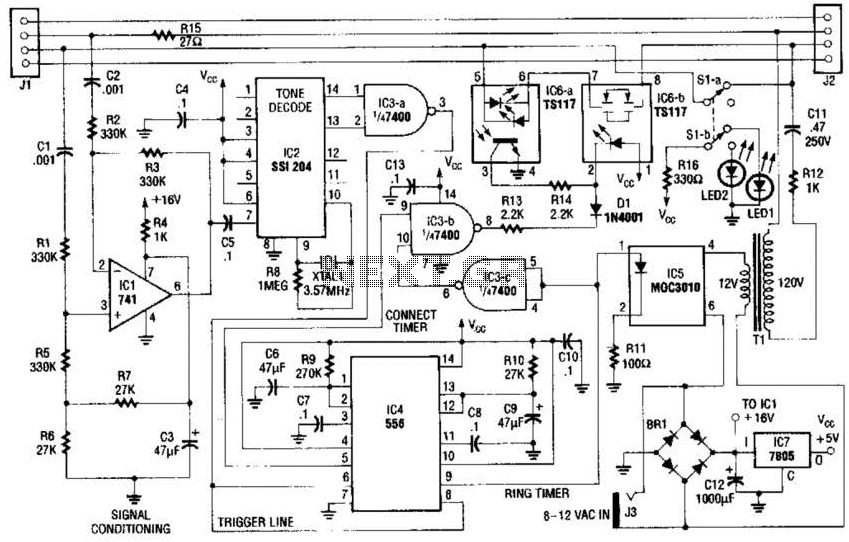
Electrolytic Capacitor Reforming Circuit

Sometimes electrolytic capacitors that are stored for a period may exhibit high leakage currents. Before utilizing these capacitors, it may be necessary to reform them. This power supply can be employed for the reforming process. Adjust resistor R4 according to the capacitor's rated voltage and set switch S2 to position X. When meter Ml indicates the rated voltage, the reforming process is complete. For larger capacitors, use position 2 initially, and then switch to position 3 after the reforming has commenced. Transformer TX can be any transformer rated between 12 to 24 Vac at approximately 1A.
The described circuit functions as a reforming power supply specifically designed for electrolytic capacitors that have been stored for extended periods. These capacitors often develop high leakage currents, which can compromise their performance in circuits. The reforming process involves applying a controlled voltage to the capacitors to restore their functionality and reduce leakage.
The circuit includes a variable resistor, R4, which allows for the adjustment of the output voltage to match the rated voltage of the capacitor being reformed. The switch S2 is utilized to select the appropriate mode for the reforming process. In position X, the circuit applies a gradual voltage increase to the capacitor. This controlled application is crucial to prevent damage to the capacitor and to ensure that it can safely handle its rated voltage.
The inclusion of meter Ml is essential for monitoring the voltage applied to the capacitor. Once the meter indicates that the rated voltage has been reached, it signifies that the reforming process is complete, and the capacitor can be safely utilized in its intended application.
For larger electrolytic capacitors, the circuit provides flexibility by allowing the user to initially set S2 to position 2. This setting enables a lower voltage application to start the reforming process gently. After a certain duration, the user can switch to position 3 to continue the reforming at a higher voltage, ensuring effective restoration of the capacitor's performance.
The transformer TX is a key component in this circuit, providing the necessary AC voltage for the reforming process. A transformer rated between 12 to 24 Vac at approximately 1A is suitable for this application, ensuring that the circuit can deliver the required power without exceeding the ratings of the components involved. Proper implementation of this power supply circuit will effectively restore the functionality of stored electrolytic capacitors, making them safe for use in electronic applications. Sometimes electrolytic capacitors that are stored for some time will exhibit high leakage currents . Before placing these in service, the capacitors might need to be reformed. This power supply can be used for reforming. Adjust R4 for the capacitor"s rated voltage and set S2 in position X. When Ml indicates the rated voltage, reforming is complete. For large capacitors, use position 2, and then position 3 after reforming starts. TX can be any transformer with a rating of 12 to 24 Vac at about 1A.
The described circuit functions as a reforming power supply specifically designed for electrolytic capacitors that have been stored for extended periods. These capacitors often develop high leakage currents, which can compromise their performance in circuits. The reforming process involves applying a controlled voltage to the capacitors to restore their functionality and reduce leakage.
The circuit includes a variable resistor, R4, which allows for the adjustment of the output voltage to match the rated voltage of the capacitor being reformed. The switch S2 is utilized to select the appropriate mode for the reforming process. In position X, the circuit applies a gradual voltage increase to the capacitor. This controlled application is crucial to prevent damage to the capacitor and to ensure that it can safely handle its rated voltage.
The inclusion of meter Ml is essential for monitoring the voltage applied to the capacitor. Once the meter indicates that the rated voltage has been reached, it signifies that the reforming process is complete, and the capacitor can be safely utilized in its intended application.
For larger electrolytic capacitors, the circuit provides flexibility by allowing the user to initially set S2 to position 2. This setting enables a lower voltage application to start the reforming process gently. After a certain duration, the user can switch to position 3 to continue the reforming at a higher voltage, ensuring effective restoration of the capacitor's performance.
The transformer TX is a key component in this circuit, providing the necessary AC voltage for the reforming process. A transformer rated between 12 to 24 Vac at approximately 1A is suitable for this application, ensuring that the circuit can deliver the required power without exceeding the ratings of the components involved. Proper implementation of this power supply circuit will effectively restore the functionality of stored electrolytic capacitors, making them safe for use in electronic applications. Sometimes electrolytic capacitors that are stored for some time will exhibit high leakage currents . Before placing these in service, the capacitors might need to be reformed. This power supply can be used for reforming. Adjust R4 for the capacitor"s rated voltage and set S2 in position X. When Ml indicates the rated voltage, reforming is complete. For large capacitors, use position 2, and then position 3 after reforming starts. TX can be any transformer with a rating of 12 to 24 Vac at about 1A.





